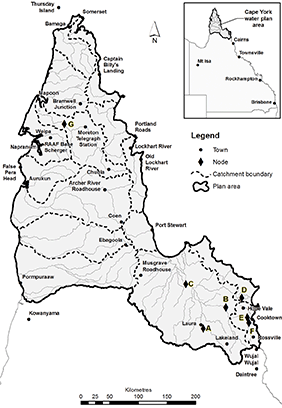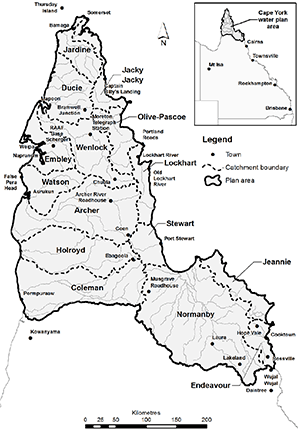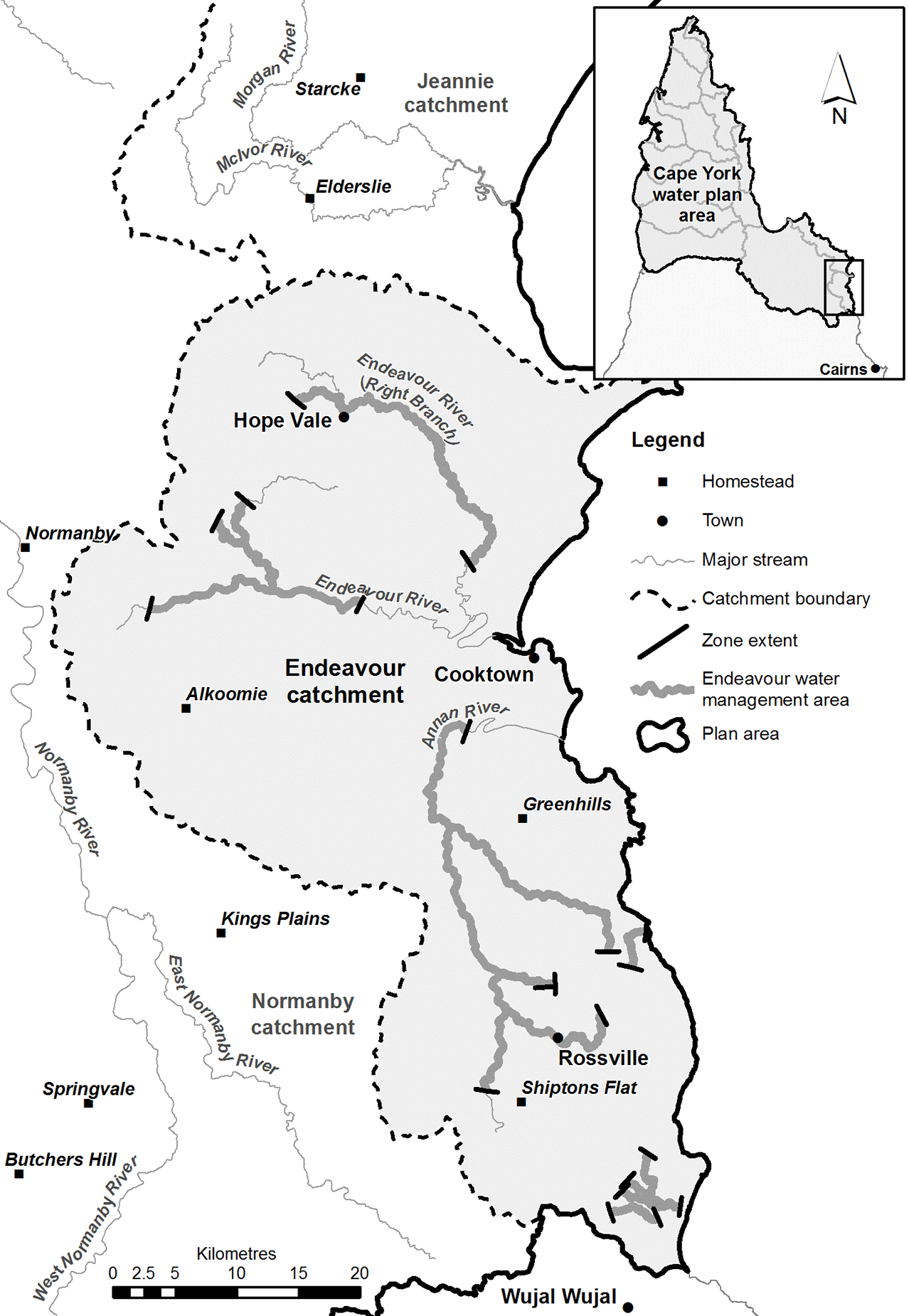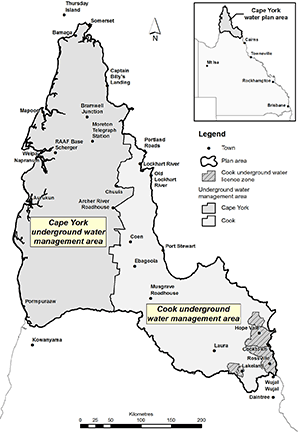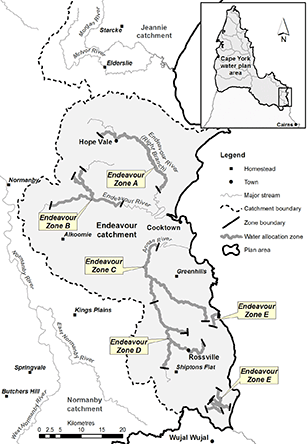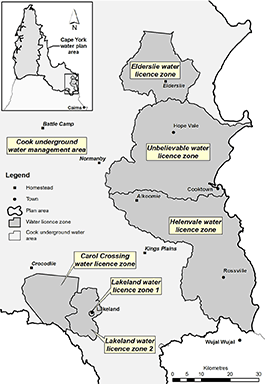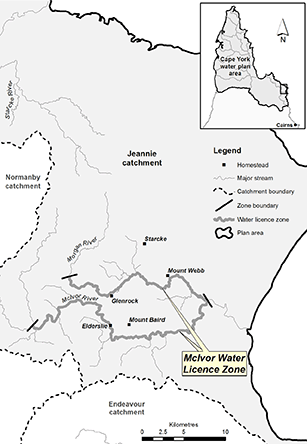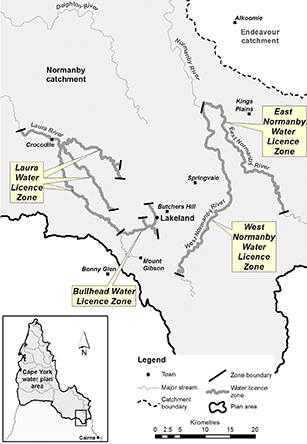This plan may be cited as the Water Plan (Cape York) 2019.
The purposes of this plan are—(a)to define the availability of water to which this plan applies; and(b)to provide a framework for sustainably managing water to which this plan applies; and(c)to identify priorities and mechanisms for dealing with future water requirements in the plan area; and(d)to regulate the taking of and interference with surface water, and the taking of underground water, to which this plan applies; and(e)to provide a framework for establishing and managing water allocations; and(f)to provide access to water resources to help Aboriginal people and Torres Strait Islanders achieve their economic, social and cultural aspirations; and(g)to provide a framework for preventing or, if practicable, reversing the degradation of natural ecosystems caused by the taking of and interference with water to which this plan applies.
The dictionary in schedule 9 defines particular words used in this plan.
Surface water is—(a)water in a watercourse, lake or spring; or(b)overland flow water.
5Water to which plan applies—Act, s 43
(1)For section 43(1)(a) of the Act, this plan applies to surface water and underground water in the plan area.(2)However, this plan does not apply to—(a)surface water in a spring connected to water to which the Water Plan (Great Artesian Basin and Other Regional Aquifers) 2017 applies; or(b)underground water to which the Water Plan (Great Artesian Basin and Other Regional Aquifers) 2017 applies.
This plan applies to the area shown as the plan area on the map in schedule 1.
(1)The plan area is divided into catchments.(2)Each part of the plan area shown as a catchment on the map in schedule 2 is a catchment.(3)A reference in this plan to a catchment by name is a reference to the catchment given that name on the map in schedule 2.
8Water management areas—Act, sch 4, definition water management area
For schedule 4 of the Act, definition water management area, paragraph (b), the part of the Endeavour catchment shown as the Endeavour water management area on the map in schedule 3 is a water management area.
9Underground water management areas
(1)The plan area is divided into underground water management areas.(2)Each part of the plan area shown as an underground water management area on the map in schedule 4 is an underground water management area.
Each part of the Endeavour catchment shown as a water allocation zone on the map in schedule 5 is a water allocation zone.
(1)Each part of the plan area shown as a water licence zone on a map in schedule 6 is a water licence zone.(2)A reference in this plan to a water licence zone by name is a reference to the water licence zone given that name on the map in schedule 6.
For section 43(1)(e)(i) of the Act—(a)a water allocation zone is a trading zone for water allocations; and(b)a water licence zone is a trading zone for water licences.
(1)A node is a point in the plan area.(2)The location of each node is identified by a letter on the map, and described in the table, in schedule 1.(3)A node may be referred to in this plan by its letter.
The exact location of the boundaries of each of the following is held in digital electronic form by the department and may be accessed at each office of the department—(a)the plan area;(b)a catchment;(c)a water management area;(d)an underground water management area;(e)a water allocation zone;(f)a water licence zone.The location of each office of the department is available on the department’s website.
This part states, for section 43(1)(b) of the Act, the water plan outcomes for this plan.
A water plan outcome for this plan is that water to which this plan applies is to be allocated and managed in a way that—(a)recognises the natural state of watercourses, lakes, springs and aquifers may change because of the taking of, or interference with, water; and(b)seeks to achieve a balance between—(i)the economic water plan outcomes stated in section 17; and(ii)the social water plan outcomes stated in section 18; and(iii)the cultural water plan outcomes stated in section 19; and(iv)the environmental water plan outcomes stated in section 20; and(c)promotes improved understanding of—(i)matters affecting the flow-related, and underground water dependent, health of ecosystems, including springs, in the plan area; and(ii)the flow requirements of ecosystems in the plan area; and(iii)the water required for social, spiritual and cultural uses by Aboriginal people and Torres Strait Islanders; and(iv)the water required to deliver social and economic benefits to communities in the plan area; and(v)the impact of climate change on water availability.
17Water plan outcomes—economic
(1)The economic water plan outcomes for this plan are—(a)to maintain the probability of being able to take water to which this plan applies under an authorisation; and(b)to support the effective and efficient operation of the market in water allocations and relocatable water licences; and(c)to facilitate economic development through the growth and expansion of industries dependent on water resources in the plan area; and(d)to maintain the availability of water to which this plan applies for industries dependent on water resources in the plan area, including, for example, grazing, irrigated agriculture, mining, fishing and tourism; and(e)to make water to which this plan applies available to support the economic aspirations of Aboriginal people and Torres Strait Islanders; and(f)to provide a flow regime that supports the suitability of water for industries dependent on water resources in the plan area.(2)In this section—relocatable water licence means a water licence that the water management protocol states may be relocated, in whole or in part, by amending the licence to change the location from which water may be taken under the licence.
The social water plan outcomes for this plan are—(a)to maintain—(i)the availability of water to which this plan applies for the supply of urban water to towns and communities dependent on the water resources of the plan area; and(ii)the flows of water to which this plan applies that support water-related aesthetic, environmental, non-indigenous cultural and recreational values; and(iii)a flow regime that supports the suitability of water for water-related aesthetic, cultural and recreational values; and(b)to provide water to which this plan applies for domestic purposes in the plan area; and(c)to make water to which this plan applies available to support the social aspirations of Aboriginal people and Torres Strait Islanders.
19Water plan outcomes—cultural
The cultural water plan outcomes for this plan are—(a)to make water to which this plan applies available to support the cultural aspirations of Aboriginal people and Torres Strait Islanders; and(b)to maintain the flows of water to which this plan applies that support the water-related cultural, spiritual and social values of Aboriginal people and Torres Strait Islanders; and(c)to support the continuation of the cultural knowledge and practices of Aboriginal people and Torres Strait Islanders that relate to water for future generations; and(d)to recognise and respect the cultural and spiritual connection to water of Aboriginal people and Torres Strait Islanders; and(e)to engage Aboriginal people and Torres Strait Islanders, as the traditional custodians and owners of land, in the management and allocation of water in the plan area; and(f)to integrate knowledge about Aboriginal tradition, Island custom and science into the processes for making decisions about the future management, allocation and use of water in the plan area.
20Water plan outcomes—environmental
(1)The environmental water plan outcomes for this plan are—(a)to minimise changes to flows of water, including natural variability of flows, in the plan area that support—(i)waterholes as refugia; and(ii)fish spawning, fish movement and fish recruitment; and(iii)floodplain ecosystems; and(iv)wetlands; and(v)river-forming processes; and(vi)riffle habitats; and(vii)environmental values and water quality objectives established under the Environmental Protection (Water) Policy 2009 for water in a catchment in the plan area, and water that flows from that catchment to the Great Barrier Reef and the Gulf of Carpentaria; and(b)to maintain an underground water regime in the plan area that supports ecosystems dependent on the underground water to which this plan applies; and(c)to provide a flow regime that—(i)maintains the flow of fresh water from estuaries in the plan area to the marine waters of the Great Barrier Reef and the Gulf of Carpentaria; and(ii)supports productive ecosystems in the receiving waters of the Great Barrier Reef and the Gulf of Carpentaria.(2)In this section—fish recruitment means the successful development and growth of juvenile fish to a stage at which the fish are able to reproduce.receiving waters means waters that receive flows of water from the plan area.
21General measures that contribute to achieving water plan outcomes
(1)Measures that contribute to achieving the water plan outcomes stated in sections 17(1)(a) and 20(1) are—(a)by 31 December 2022, all water entitlements are measured as directed by the chief executive; and(b)all water entitlements granted after the commencement are measured, as directed by the chief executive, when they are granted.(2)A measure that contributes to achieving the water plan outcomes stated in sections 16 to 20 is, by 30 June 2020, the chief executive develops a monitoring, evaluation and reporting strategy to support the assessment of the effectiveness of this plan and its implementation.(3)A measure that contributes to achieving the water plan outcomes stated in section 16(a) and 20(1)(b) is, by 30 June 2020, the chief executive develops a monitoring, evaluation and reporting strategy to support the assessment of springs and the underground water regime in the Lakeland water licence zones 1 and 2.(4)A measure that contributes to achieving the water plan outcome stated in section 17(1)(a) is, within 5 years after the commencement, the chief executive authorises, under the water management protocol, the use or continued use of existing works to take overland flow water.
22Measures that contribute to achieving particular economic and social water plan outcomes
Measures that contribute to achieving the water plan outcomes stated in sections 17(1)(b) and (e) and 18(c) are—(a)information about the number and volume of water licence trades is collected and analysed; and(b)information about the number, value and volume of water allocation trades is collected and analysed; and(c)opportunities to improve the effectiveness and efficiency of the market in tradeable water entitlements are analysed; and(d)the chief executive publishes the information and analysis mentioned in paragraphs (a) and (b) within 5 years after the commencement; and(e)water entitlements authorising the taking of unallocated water in the Cape York Peninsula Heritage Area, reserved under this plan, are granted to eligible persons for achieving the water plan outcome mentioned in section 19(a) within 5 years after the commencement.See section 31 for unallocated water reserved under this plan.
23Environmental flow objectives and performance indicators—Act, s 43
(1)For section 43(1)(d) of the Act, the environmental flow objectives for surface water to which this plan applies are stated in schedule 7.(2)The performance indicators for the environmental flow objectives are stated in schedule 7.
24Water allocation security objectives and performance indicators—Act, s 43
(1)For section 43(1)(e)(ii) of the Act, the water allocation security objectives for taking unsupplemented water to which this plan applies are as follows—(a)for water allocation group class 1—an annual volume probability of at least 80%;(b)for water allocation group class 2—an annual volume probability of at least 50%.See section 45 in relation to the water allocation groups for this plan.(2)The performance indicator for the water allocation security objective for each water allocation group mentioned in subsection (1) is the annual volume probability stated for the water allocation group.(3)In this section—annual volume probability, for a water allocation group, means the percentage of the years in the simulation period in which the volume of water permitted to have been taken by the group was at least the total of the nominal volumes for the allocations in the group.
25Decisions to be consistent with objectives
A decision made by the chief executive, under chapter 2 of the Act about the allocation or management of water to which this plan applies, other than a decision about a water permit, must be consistent with—(a)the environmental flow objectives stated in section 23; and(b)the water allocation security objectives stated in section 24.
26Assessing impact of decisions about surface water
(1)The Source Rivers computer program’s simulation for the simulation period must be used—(a)to assess, for section 25, the consistency of a decision with the environmental flow objectives and the water allocation security objectives; and(b)to assist the chief executive to decide flow conditions for water licences.(2)If it is not practicable to use the Source Rivers computer program’s simulation, another assessment method approved by the chief executive may be used.(3)The chief executive may approve an assessment method for subsection (2) if the chief executive is satisfied the method will accurately assess—(a)for section 25, the consistency of a decision with the environmental flow objectives and the water allocation security objectives; and(b)the water plan outcomes for this plan.
27Limitations on taking or interfering with water for prescribed activities—Act, s 101
(1)For section 101(1) of the Act, during a water year, a person must not take a total of more than 5ML of water to which this plan applies for activities prescribed under section 101(1)(a) of the Act.(2)However, a person must not take underground water to which this plan applies from Lakeland water licence zone 1 or 2 for an activity prescribed under section 101(1)(a) of the Act.
28Limitation on taking overland flow water—Act, s 101
For section 101(1) of the Act, a person must not, under section 101(1)(b) of the Act, take overland flow water to which this plan applies unless—(a)the water is taken under a water licence; or(b)the water is taken for stock purposes or domestic purposes; or(c)the water is taken using existing works in the plan area and the take of overland flow water is authorised under the water management protocol; or(d)the water is taken using works, other than existing works, if—(i)the chief executive received a notice about the construction of the works before 31 July 2018; and(ii)if a development approval is required for the works—the development approval is granted on or before 31 December 2021; and(iii)the take of water is authorised under the water management protocol; or(e)the water is taken in a catchment, other than the Normanby catchment, using works that have a capacity of not more than 50ML.See section 101(3) of the Act for when a person can not be prevented from taking overland flow water that is contaminated agricultural run-off.
29Limitation on taking or interfering with underground water—Act, s 101
For section 101(1) of the Act, a person must not take underground water to which this plan applies under section 101(1)(c) of the Act, from an underground water management area, unless—(a)the water is taken under a water licence or water permit; or(b)the water is taken for stock purposes or domestic purposes.
30Limitation on authorisation to take water for stock or domestic purposes—Act, s 103
For section 103(a) of the Act, the water may be taken—(a)for the Endeavour catchment, Jeannie catchment or Normanby catchment, only—(i)from a location stated on a water licence; and(ii)in a way authorised under a water licence; and(b)for another catchment in the plan area—in any way.
31Unallocated water reserved under this plan—Act, s 43
(1)For section 43(1)(c) of the Act, the volume of unallocated water reserved under this plan is 516,350ML.(2)The unallocated water reserved in a catchment is held as 1 or more of the following types of reserve—(a)a Cape York Peninsula Heritage Area reserve;(b)a strategic reserve;(c)a general reserve.See the water management protocol for the volumes of unallocated water held for particular parts of the plan area.
32Purpose for which unallocated water held as reserve may be granted
(1)Unallocated water held as a Cape York Peninsula Heritage Area reserve may be granted to an eligible person to help an Aboriginal or Torres Strait Islander community in the Cape York Peninsula Region achieve its economic and social aspirations.(2)Unallocated water held as a strategic reserve may be granted—(a)for a State purpose; or(b)to an eligible person for a project for the economic or social benefit of Aboriginal people or Torres Strait Islanders.(3)Unallocated water held as a general reserve may be granted for any purpose.(4)Each of the following is a State purpose—(a)a coordinated project;(b)a project of regional significance;(c)a town water supply purpose.(5)A project is a project of regional significance if the chief executive considers the project is significant for a region in the plan area after considering the following matters—(a)the outcomes stated in part 3;(b)the economic or social impact the project will have on the region;(c)the public interest and the welfare of people in the region;(d)any other relevant matter.(6)An eligible person is—(a)an entity that holds land under the Aboriginal Land Act 1991 or Torres Strait Islander Land Act 1991; or(b)a native title holder under the Native Title Act 1993 (Cwlth).
33Offer for particular water licences
(1)Subsection (2) applies to an eligible person if—(a)the eligible person has an interest in land in a catchment; and(b)on the commencement, there is unallocated water held as a Cape York Peninsula Heritage Area reserve in the catchment.(2)The chief executive must offer to grant the eligible person a water licence to take water to be released from the Cape York Peninsula Heritage Area reserve in the catchment for the purpose mentioned in section 32(1).(3)Subsection (4) applies to an eligible person if—(a)the eligible person has an interest in land in a catchment; and(b)on the commencement, there is no unallocated water held as a Cape York Peninsula Heritage Area reserve in the catchment.(4)The eligible person may ask the chief executive, in writing, to offer to grant the person a water licence to take water to be released from a strategic reserve in the catchment for a project mentioned in section 32(2)(b).
34Processes for releasing unallocated water—Act, s 43
(1)For section 43(2)(f) of the Act, this section states the process for releasing unallocated water reserved under this plan.(2)The processes for releasing unallocated water stated in the Water Regulation 2016, part 2, division 2, subdivision 2 and the water management protocol apply for releasing unallocated water—(a)held as a general reserve; or(b)if the water is being released for a State purpose—held as a strategic reserve.See also section 43(3) of the Act for how this section does not override, or prevent, a limitation, a condition or a matter that must or may be considered under this plan.(3)Subject to section 33, the process for releasing unallocated water stated in the water management protocol applies for releasing unallocated water—(a)held as a Cape York Peninsula Heritage Area reserve; or(b)if the water is being released for a project mentioned in section 32(2)(b)—held as a strategic reserve.
35Expiry of water entitlement granted for particular projects
(1)A water entitlement granted for a coordinated project or a project of regional significance from water released from a strategic reserve expires when the project ends.(2)When the water entitlement expires, the volume of water granted under the entitlement becomes unallocated water held as a strategic reserve.
For section 43(2)(g) of the Act, this part states the arrangements and process for converting, under a water entitlement notice for this plan, particular water licences to water allocations.
(1)This part applies if a water entitlement notice for this plan provides for a water licence to take unsupplemented water from the Endeavour water management area to be converted to a water allocation (a new water allocation) to take unsupplemented water.(2)In a provision about the new water allocation, a reference to the water licence being converted is a reference to the water licence that is converted to the new water allocation under section 146 of the Act.
The location from which water may be taken under the new water allocation must be in a water allocation zone.
The purpose stated on the new water allocation must be ‘urban’ or ‘any’.
(1)The chief executive must decide the nominal volume for the new water allocation based on an assessment of the water taken under the water licence being converted.See the Water Regulation 2016, section 46 for the matters the chief executive must consider in deciding the nominal volume for the new water allocation.(2)For the Water Regulation 2016, section 46(1)(e), in deciding the nominal volume for the water allocation, the chief executive must also have regard to the simulated mean annual diversion for the water allocation.(3)In this section—simulated mean annual diversion, for the new water allocation, means—(a)the total volume of water simulated to have been taken under the water allocation—(i)using the Source Rivers computer program; and(ii)as if the new water allocation had been in existence for the whole of the simulation period; and(b)divided by the number of years in the simulation period.
The maximum rate for the new water allocation must be—(a)if the water licence being converted states the volume of water that may be taken under the licence in a day—the stated volume; or(b)if paragraph (a) does not apply, but the water licence being converted states a maximum volume of water, expressed in litres, that may be taken under the licence in a second—the volume, expressed in megalitres, calculated by multiplying the stated maximum volume by 0.0864 and rounded to the nearest 1 decimal point; or(c)otherwise—the maximum rate decided by the chief executive after considering the matters stated in section 43.See also the Water Regulation 2016, sections 50 to 52.
The volumetric limit for the new water allocation must be—(a)if the water licence being converted states the volume of water that may be taken under the licence in a water year—the stated volume; or(b)if paragraph (a) does not apply and the water licence being converted states an area, in hectares, that may be irrigated by water taken under the licence—the volume, in megalitres, calculated by multiplying the stated area by 12; or(c)otherwise—the volume decided by the chief executive after considering the matters stated in section 43.
43Matters for deciding maximum rate or volumetric limit
(1)For sections 41(c) and 42(c), the matters are—(a)the conditions under which water may be taken under the water licence being converted; and(b)the volume of water required for the purpose for which water may be taken under the licence; and(c)the water-taking capacity, under normal operating conditions, of—(i)a pump that relates to an activity authorised under the licence or a related development permit; and(ii)any other works authorised for taking water under the licence; and(d)the irrigation or water distribution system related to the pump or other works during the previous period; and(e)the annual volume of water estimated by the chief executive to have been taken under the licence during the previous period; and(f)the efficiency of the water use associated with—(i)the pump or other works mentioned in paragraph (c) or the irrigation or water distribution system mentioned in paragraph (d); and(ii)the volume of water mentioned in paragraph (e).(2)In this section—previous period means—(a)if the water licence being converted was granted more than 10 years before the commencement—the period of 10 years immediately before the commencement; or(b)otherwise—the period that started when the licence was granted and ended on the commencement.
(1)The chief executive may impose on the new water allocation any condition the chief executive is satisfied is necessary to ensure the purposes and outcomes of this plan are achieved.(2)When deciding the conditions under which water may be taken under the new water allocation, the chief executive must consider the conditions stated on the water licence being converted.
45Water allocation groups—Act, sch 4, definition water allocation group
For schedule 4 of the Act, definition water allocation group—(a)the groups of water allocations for this plan are—(i)water allocation group class 1; and(ii)water allocation group class 2; and(b)the new water allocation is in the water allocation group stated on the water allocation.
46Applications for water licences that must not be accepted
For section 43(2)(j) of the Act, the chief executive must not accept an application for a water licence made under section 107 of the Act unless it is an application—(a)for a water licence to take water for stock purposes or domestic purposes; or(b)to which division 2 applies.
47Deciding applications for relocating or seasonal water assignment—Act, s 43
(1)For section 43(2)(i) of the Act, this section applies to—(a)an application for relocating a water licence; or(b)an application for a seasonal water assignment of a water licence.(2)The chief executive may decide to grant the application if—(a)the application is to change the location from which water may be taken under the licence from a location in a water licence zone to another location in a water licence zone; and(b)the dealing is permitted under the water management protocol.(3)Also, the chief executive may decide to grant an application for a seasonal water assignment of the licence if—(a)the application is to change the location from which water may be taken under the licence from a location not in a water licence zone to another location not in a water licence zone; and(b)the dealing is permitted under the water management protocol.
48Applications for dealings with water licences inconsistent with this plan—Act, s 129
(1)This section applies for an application for a dealing with a water licence, other than—(a)an application for a dealing that—(i)relates to a water licence to take water granted from a Cape York Peninsula Heritage Area reserve; and(ii)is permitted under the water management protocol; or(b)an application the chief executive is permitted to grant under section 47.(2)Granting the application would be inconsistent with this plan if granting the application would—(a)increase the amount of water that may be taken under the licence; or(b)increase the rate at which water may be taken under the licence; or(c)change the location of taking or interfering with water under the licence; or(d)increase or change the interference with water under the licence.See section 129 of the Act for the actions the chief executive must take in relation to an application for a dealing with a water licence, including refusing the application, if granting the application would be inconsistent with a water plan.
(1)This division applies to an application for a water licence to interfere with water in a watercourse to which this plan applies.(2)This division does not limit the matters the chief executive may consider when deciding the application.
50Matters for deciding applications
In deciding the application, the chief executive must consider the impact the proposed interference with water in the watercourse may have on—(a)in-stream water levels in the watercourse; and(b)the natural movement of sediment; and(c)the bed and banks of the watercourse; and(d)riparian vegetation; and(e)habitats for native plants and animals; and(f)the movement of fish and other aquatic species; and(g)the cultural and environmental values of the watercourse.
51Limitations on interference with water
The water licence may be granted if the proposed interference—(a)does not interfere with the flow of water—(i)into or from a lake or waterhole; or(ii)in or from a spring; or(b)is for the purpose—(i)of storing water for stock purposes or domestic purposes; or(ii)of providing a pumping pool to enable water to be taken under a water entitlement; or(iii)of providing improved security for town water supplies taken under an authorisation; or(iv)if the proposed interference relates to the release of unallocated water—for which the water is released; or(v)of a further proposed interference with, or storing of, water for a purpose not related to the taking of water under a water entitlement.Examples of a purpose for subparagraph (v)—
community landscaping, retaining water for flood mitigation purposes, storing water for a micro-hydroelectric power scheme or diverting a watercourse for the construction of a railway
52Interference with water for stock purposes or domestic purposes
(1)This section applies if the proposed interference with water is to store water taken under an authorisation for stock purposes or domestic purposes.(2)In deciding the application, the chief executive must consider—(a)existing water supplies for stock purposes or domestic purposes on land to which the application relates, including, for example, existing weirs, underground water and storage for taking overland flow water; and(b)the availability of water at the proposed storage site.(3)Also, the chief executive must ensure the proposed storage capacity authorised under the water licence is not greater than—(a)the storage capacity that is necessary to store water taken under a water entitlement for stock purposes or domestic purposes having regard to the existing water supplies mentioned in subsection (2)(a); and(b)either—(i)for a water licence to interfere with water in the Endeavour catchment, Jeannie catchment or Normanby catchment—20ML; or(ii)otherwise—250ML.
53Interference with water for pumping pool
(1)This section applies if the proposed interference with water is to provide a pumping pool to enable water to be taken under a water entitlement.(2)The chief executive must ensure the proposed storage capacity authorised under the water licence is not greater than—(a)for a water licence to interfere with water in the Endeavour catchment—2ML; or(b)otherwise—20ML.
54Interference with water to improve security for town water supply
(1)This section applies if the proposed interference with water is to improve security for town water supplies taken under an authorisation.(2)The chief executive may grant the application if the chief executive is satisfied that—(a)appropriate water supply security strategies, including water demand strategies and plans for drought management, are in place; and(b)there is a need for an increased reliability of the water supply.
55Interference with water related to the granting of unallocated water
(1)This section applies if the proposed interference with water relates to the release of unallocated water.(2)The interference must not be greater than is necessary for the purpose for which the unallocated water is granted.
56Process for granting water licences to authorise particular existing activities
(1)This section applies if a water entitlement notice for this plan provides for the granting of a water licence to take surface water or underground water.(2)For section 116(1) of the Act, the chief executive must decide to grant the water licence.See also section 116(2) of the Act for when the chief executive may grant a water licence without the need for an application to be made under section 107 of the Act.
(1)This division applies to—(a)a water licence granted by the chief executive under the Act in accordance with this plan; or(b)a water licence to take water to which this plan applies that is amended under section 133 of the Act for consistency with this plan.(2)However, this division does not apply to a water licence to interfere with, by diversion, the flow of water to which this plan applies.
In this division—pre-amended licence, in relation to a water licence being amended under section 133 of the Act for consistency with this plan, means the water licence before it is amended.
59Contents for water licences to take water
(1)If the water licence is a water licence to take water from a watercourse, lake or spring, the water licence must state—(a)one of the following as the purpose for which the water may be taken under the licence—(i)‘CYPHA’;‘CYPHA’ is an abbreviation for Cape York Peninsula Heritage Area.(ii)‘stock and domestic’;(iii)‘relift’;(iv)‘urban’;(v)‘any’; and(b)for a licence with a stated purpose of ‘stock and domestic’, ‘urban’ or ‘any’—the maximum rate for the licence; and(c)the volumetric limit for the licence; and(d)the conditions, if any, for the licence.(2)If the water licence is a water licence to take underground water, the water licence must state—(a)one of the following as the purpose for which the water may be taken under the licence—(i)‘CYPHA’;(ii)‘urban’;(iii)‘any’; and(b)the volumetric limit for the licence; and(c)the conditions, if any, for the licence.(3)Subsection (2) does not apply to a water licence with a stated purpose of mine dewatering.(4)If the water licence is a water licence to take overland flow water, the water licence must state—(a)one of the following as the purpose for which the water may be taken under the licence—(i)‘CYPHA’;(ii)‘urban’;(iii)‘any’; and(b)at least 1 of the following—(i)the maximum rate for the licence;(ii)the maximum storage capacity of works that may be used to store water taken under the licence;(iii)the volumetric limit for the licence; and(c)the conditions, if any, for the licence.
60Purpose to be stated on amended licence
(1)This section applies if the water licence is being amended.(2)The purpose stated on the water licence must be—(a)if the purpose stated on the pre-amended licence is ‘stock or domestic’, ‘relift’ or ‘urban’—the stated purpose; or(b)if the chief executive is satisfied that water taken under the pre-amended licence is used for a relift purpose—‘relift’; or(c)otherwise—‘any’.(3)For subsection (2)(b), water taken under a water licence is used for a relift purpose if the water is—(a)taken from a watercourse, lake, spring or works under the licence; and(b)released into a watercourse, lake, spring or works for the purpose of being taken from the watercourse, lake, spring or works under another authorisation.
The maximum rate for the water licence must be—(a)for a water licence being amended—(i)if the pre-amended licence states the volume of water that may be taken in a day—the stated volume; or(ii)if subparagraph (i) does not apply, but the pre-amended licence states a maximum volume of water, expressed in litres, that may be taken under the licence in a second—the volume, expressed in megalitres, calculated by multiplying the stated maximum volume by 0.0864 and rounded to the nearest 1 decimal point; or(iii)otherwise—the volume decided by the chief executive after considering the matters stated in section 63; or(b)for a water licence being granted—the volume decided by the chief executive after considering the matters stated in section 63.
The volumetric limit for the water licence must be—(a)for a water licence being amended—(i)if the pre-amended licence states the volume of water that may be taken under the licence in a water year—the stated volume; or(ii)if subparagraph (i) does not apply, but the pre-amended licence states an area, in hectares, that may be irrigated by water taken under the licence—the volume, in megalitres, calculated by multiplying the stated area by 12; or(iii)otherwise—the volume decided by the chief executive after considering the matters stated in section 63; or(b)for a water licence being granted—the volume decided by the chief executive after considering the matters stated in section 63.
63Matters for deciding maximum rate or volumetric limit
(1)For sections 61(a)(iii) and (b) and 62(a)(iii) and (b), the matters for a water licence being amended or granted are—(a)the type of licence; and(b)the conditions under which water may be taken under the licence; and(c)the volume of water required for the purpose for which water may be taken under the licence; and(d)the water-taking capacity and use, under normal operating conditions—(i)for a water licence being granted—of relevant works that relate to an activity authorised under the licence; and(ii)for a water licence being amended or granted—of other works authorised for taking water under section 28(c) or (d); and(e)for a water licence being amended—the annual volume of water estimated by the chief executive to have been taken under the licence during each year of the previous period; and(f)the efficiency of the water use associated with—(i)the pump or other works mentioned in paragraph (d); and(ii)the water mentioned in paragraph (e).(2)In this section—previous period, for a pre-amended licence, means—(a)if the pre-amended licence was granted more than 10 years before the commencement—the period of 10 years immediately before the commencement; or(b)otherwise—the period that started when the pre-amended licence was granted and ended on the commencement.relevant works means works—(a)used, or capable of being used, to take water to which this plan applies; and(b)that existed immediately before the commencement, regardless of whether the works were completed or partially completed.
64Contents for water licences to interfere with water
(1)If the water licence is a water licence to interfere with water in a watercourse for the storage of water, the water licence must state—(a)the maximum volume of water that may be stored under the licence; and(b)the maximum height of a structure used to store water under the licence at the full supply level for the structure; and(c)the conditions, if any, for the licence, including, for example—(i)a pass flow condition; and(ii)a condition requiring outlet works to be available and maintained at all times sufficient for the pass flow condition; and(iii)a condition requiring a bywash or spillway.(2)If the water licence is a water licence to interfere with water in a watercourse, other than for the storage of water, the water licence must state—(a)the maximum size, including the height, width or length, of a structure used to interfere with water under the licence;(b)the conditions, if any, for the licence.(3)In this section—pass flow condition, for a water licence to interfere with the flow of water in a watercourse by impounding the flow of water, means a condition that states the minimum rate of flow at which water interfered with under the licence must be allowed to pass freely in the watercourse at, or downstream, of the location of the interference.
(1)The chief executive may impose on the water licence any condition the chief executive is satisfied is necessary to ensure the purposes and water plan outcomes of this plan are achieved.(2)When deciding the conditions under which water may be taken under a water licence being amended, the chief executive must consider the conditions stated on the pre-amended licence.(3)When deciding the conditions under which water may be interfered with by impoundment under a water licence, the chief executive must consider the following matters—(a)the size of the impoundment;(b)the catchment size above the impoundment;(c)the timing, extent and volume of inflows into the impoundment;(d)any impact on existing downstream entitlement holders;(e)downstream water requirements for environmental, cultural and social needs;(f)if a development permit was granted—the conditions of the permit.
66Water management protocol—Act, s 43
(1)For section 43(2)(l) of the Act, a water management protocol must be prepared for the plan area.(2)The water management protocol must address the following matters for the plan area—(a)the volumes of unallocated water reserved for stated purposes or stated locations;(b)the process for releasing unallocated water—(i)held as Cape York Peninsula Heritage Area reserve; and(ii)for water that may be granted for a purpose mentioned in section 32(2)(b)—held as a strategic reserve;(c)the water allocation dealing rules;(d)the water sharing rules;(e)for section 126 of the Act, the dealing rules to amend a water licence to change the location of taking water under the water licence that are permitted;(f)the criteria and processes for deciding an application for a dealing with a water licence mentioned in section 47;(g)the arrangements and process for authorising the continued taking of overland flow water to which this plan applies after the commencement.
67Amendments to this plan that may be made without consultation—Act, s 43
For section 43(2)(m) of the Act, the following amendments may be made to this plan without public consultation—(a)an amendment to increase the volume of water held as reserves under section 31 by an amount that is not more than the volume of water that returns to the State;(b)an amendment or addition of a performance indicator or environmental flow objective if the amendment or addition does not adversely affect—(i)the provision of water to which this plan applies for the environment; or(ii)the achievement of the water plan outcomes stated in part 3; or(iii)the water allocation security objectives stated in section 24;(c)an amendment or addition of a water allocation security objective if the amendment or addition does not adversely affect—(i)the achievement of the water plan outcomes stated in part 3; or(ii)the environmental flow objectives stated in section 23;(d)an amendment or addition of a node;(e)an amendment to adjust the boundaries of the following areas if more accurate information about the boundaries, or hydrological characteristics, of the plan area becomes available—(i)the plan area;(ii)a catchment;(iii)a water management area;(iv)an underground water management area;(f)an amendment to change the period within which a measure for achieving a stated water plan outcome is to be achieved;(g)an amendment to remove a provision of this plan that no longer has effect;(h)an amendment to include another entity as an eligible person under section 32(6).
sections 6 and 13
Node | Catchment | Description |
A | Normanby | the Laura River at Coal Seam Creek (department gauging station number 105102A) |
B | Normanby | the Normanby River at Battle Camp (department gauging station number 105101A) |
C | Normanby | the Normanby River at Kalpower Crossing (department gauging station number 105107A) |
D | Jeannie | the McIvor River at Elderslie (department gauging station number 106001A) |
E | Endeavour | the Endeavour River at the end of the system |
F | Endeavour | the Annan River at the end of the system |
G | Wenlock | the Wenlock River at Jacks Camp (department gauging station number 925003A) |
1Days in dry periods—maintaining flows of water that support waterholes as refugia
(1)An environmental flow objective for surface water to which this plan applies is that the total number of days in all dry periods at each node mentioned in the following table, as a percentage of the total number of days in the simulation period, does not increase above the percentage stated opposite the node in the table.
Node
Environmental flow objective
A
5%
B
2%
C
1%
D
1%
E
1%
(2)The performance indicator, for nodes A to E, is the total number of days in all dry periods expressed as a percentage of the total number of days in the simulation period.(3)In this section—dry period, for a node, means a continuous period of more than 200 days, during the simulation period, in which daily water flows at the node are 5ML or less.A daily flow of 5ML or less for a continuous period of 200 days is unlikely to replenish the water in a waterhole.
2Days in dry periods—maintaining flows to continually flowing streams
(1)An environmental flow objective for surface water to which this plan applies is that the total number of days in all dry periods at each node mentioned in the following table, as a percentage of the total number of days in the simulation period, does not increase above the percentage stated opposite the node in the table.
Node
Environmental flow objective
F
1%
G
1%
(2)The performance indicator, for nodes F and G, is the total number of days in all dry periods expressed as a percentage of the total number of days in the simulation period.(3)In this section—dry period, for a node, means a continuous period of more than 40 days, during the simulation period, in which daily water flows at the node are 5ML or less.A daily flow of 5ML or less for a continuous period of 40 days is unlikely to maintain a continuous flow of water in a spring.
3Days between floodplain inundation events—maintaining flows of water that support floodplain ecosystems
(1)An environmental flow objective for surface water to which this plan applies is that the total number of days in all intervening periods at each node stated in the following table, as a percentage of the total number of days in the simulation period, does not increase above the percentage stated opposite the node in the table.
Node
Environmental flow objective
C
55%
G
47%
(2)The performance indicator, for nodes C and G, is the total number of days in all intervening periods expressed as a percentage of the total number of days in the simulation period.(3)In this section—2-year annual recurrence interval, for a flood, means the flood is at least as great as other flood events that occur, on average over the long-term, once every 2 years.floodplain inundation event, for a node, means a daily water flow at the node that is more than the flow rate at which the floodplain starts to fill, as represented by a flood with a 2-year annual recurrence interval.intervening period, for a node, means a continuous period of more than 2 years and 6 months, during the simulation period, between floodplain inundation events at the node.
4Days with river-forming flow—maintaining flows of water that support the river-forming processes
(1)An environmental flow objective for surface water to which this plan applies is that the total number of days with a river-forming flow at each node stated in the following table, as a percentage of the total number of days in the simulation period, does not decrease below the percentage stated opposite the node in the table.
Node
Environmental flow objective
A
1%
B
1%
C
3%
D
0.5%
G
2%
(2)The performance indicator, for nodes A, B, C, D and G, is the total number of days with a river-forming flow at the node expressed as a percentage of the total number of days in the simulation period.(3)In this section—1.5-year annual recurrence interval, for a daily water flow, means the daily water flow is at least as great as other daily water flow events that occur, on average over the long-term, once every 1.5 years.river-forming flow, at a node, means a daily water flow at the node that is more than the 1.5-year annual recurrence interval.River-forming processes are likely to occur when the daily water flow rate is more than the flow rate of a flood (a daily flow event) that recurs, on average over the long-term, once every 1.5 years.
schedule 9, definition maximum rate
Nominal pump size (mm) | Maximum rate |
32 | 0.6 |
40 | 1 |
50 | 1.5 |
65 | 2.6 |
80 | 3.9 |
100 | 5.6 |
125 | 7.8 |
150 | 9.9 |
200 | 16 |
250 | 21.6 |
300 | 25.9 |
350 | 30.2 |
400 | 37.2 |
500 | 56.2 |
600 to 660 | 95 |
750 | 160 |
800 | 201 |
authorisation see the Water Regulation 2016, schedule 19.
Cape York Peninsula Heritage Area means the part of the plan area that is located in the Cape York Peninsula Region.
Cape York Peninsula Region see the Cape York Peninsula Heritage Act 2007, section 7(1).
catchment see section 7.
coordinated project see the State Development and Public Works Organisation Act 1971, schedule 2.
eligible person see section 32(6).
existing works, in the plan area, means works—
(a)used, or capable of being used, to take overland flow water to which this plan applies, other than for stock purposes or domestic purposes; and
(b)that existed immediately before 4 June 2018, whether the works were completed or partially completed.
flow regime means the entire range of flows at a point in a watercourse including variations in the watercourse height, discharge, seasonality and annual variability.
maximum rate means—
(a)for a water licence—the maximum volume of water, in megalitres, that may be taken under the water licence during a day; or
(b)for a pump of a particular size—(i)if the pump size is stated in schedule 8—the maximum rate stated in that schedule for the pump size; or(ii)otherwise—the maximum rate decided by the chief executive after considering the maximum rates for similar pump sizes stated in schedule 8.
new water allocation see section 37(1).
node see section 13(1).
pre-amended licence, for part 10, division 4, see section 58.
project of regional significance see section 32(5).
pumping pool means a pool of water near a pump in a watercourse, lake or spring that ensures the water level of the watercourse, lake or spring is appropriate to enable the pump to function properly.
simulation period means the period from 1 January 1889 to 31 December 2013.
Source Rivers computer program means the computer program used by the department known as Source Rivers, and associated statistical analysis and reporting programs, that simulate daily stream flows, flow management, storages, releases, in-stream infrastructure, water diversions, water demands and other hydrologic events in the plan area.
State purpose see section 32(4).
supplemented water see the Water Regulation 2016, schedule 19.
surface water see section 4.
underground water management area see section 9(2).
underground water regime means the profile of underground water levels, hydraulic head and direction of underground water flow as represented by standing water levels.
unsupplemented water means water that is not supplemented water.
volumetric limit, for a water licence or water allocation, means the maximum volume of water, in megalitres, that may be taken under the water licence or water allocation during a water year.
water allocation zone see section 10.
waterhole means a part of a watercourse that contains water after the watercourse stops flowing, other than a part of the watercourse that is within the storage area of a dam or weir on the watercourse.
water licence zone see section 11(1).





